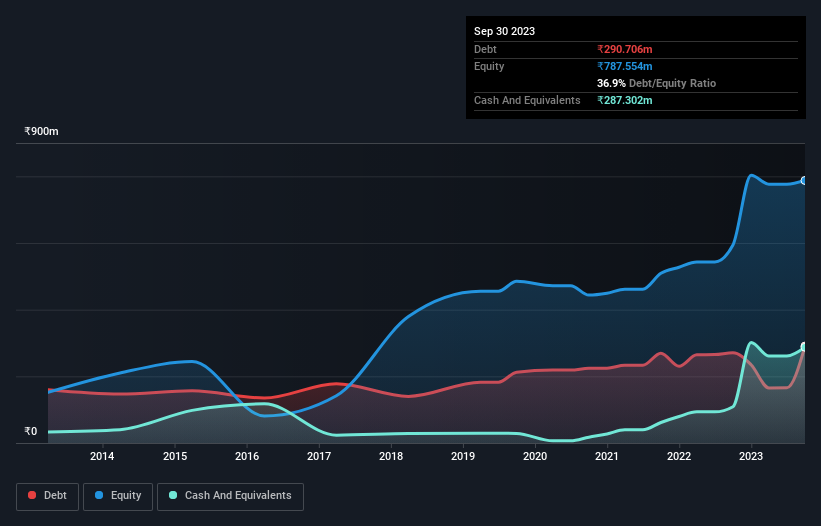Does Total Transport Systems (NSE:TOTAL) Have A Healthy Balance Sheet?
Legendary fund manager Li Lu (who Charlie Munger backed) once said, 'The biggest investment risk is not the volatility of prices, but whether you will suffer a permanent loss of capital.' It's only natural to consider a company's balance sheet when you examine how risky it is, since debt is often involved when a business collapses. As with many other companies Total Transport Systems Limited (NSE:TOTAL) makes use of debt. But should shareholders be worried about its use of debt?
When Is Debt A Problem?
Debt assists a business until the business has trouble paying it off, either with new capital or with free cash flow. If things get really bad, the lenders can take control of the business. While that is not too common, we often do see indebted companies permanently diluting shareholders because lenders force them to raise capital at a distressed price. Of course, plenty of companies use debt to fund growth, without any negative consequences. The first thing to do when considering how much debt a business uses is to look at its cash and debt together.
View our latest analysis for Total Transport Systems
What Is Total Transport Systems's Debt?
You can click the graphic below for the historical numbers, but it shows that as of September 2023 Total Transport Systems had ₹290.7m of debt, an increase on ₹270.7m, over one year. On the flip side, it has ₹287.3m in cash leading to net debt of about ₹3.40m.

How Strong Is Total Transport Systems' Balance Sheet?
The latest balance sheet data shows that Total Transport Systems had liabilities of ₹797.2m due within a year, and liabilities of ₹84.3m falling due after that. Offsetting this, it had ₹287.3m in cash and ₹868.2m in receivables that were due within 12 months. So it can boast ₹273.9m more liquid assets than total liabilities.
This short term liquidity is a sign that Total Transport Systems could probably pay off its debt with ease, as its balance sheet is far from stretched. Carrying virtually no net debt, Total Transport Systems has a very light debt load indeed.
We measure a company's debt load relative to its earnings power by looking at its net debt divided by its earnings before interest, tax, depreciation, and amortization (EBITDA) and by calculating how easily its earnings before interest and tax (EBIT) cover its interest expense (interest cover). This way, we consider both the absolute quantum of the debt, as well as the interest rates paid on it.
Total Transport Systems's net debt to EBITDA ratio is very low, at 0.035, suggesting the debt is only trivial. Although with EBIT only covering interest expenses 2.9 times over, the company is truly paying for borrowing. Importantly, Total Transport Systems's EBIT fell a jaw-dropping 61% in the last twelve months. If that earnings trend continues then paying off its debt will be about as easy as herding cats on to a roller coaster. When analysing debt levels, the balance sheet is the obvious place to start. But it is Total Transport Systems's earnings that will influence how the balance sheet holds up in the future. So when considering debt, it's definitely worth looking at the earnings trend. Click here for an interactive snapshot.
Finally, a business needs free cash flow to pay off debt; accounting profits just don't cut it. So it's worth checking how much of that EBIT is backed by free cash flow. Over the last three years, Total Transport Systems recorded negative free cash flow, in total. Debt is usually more expensive, and almost always more risky in the hands of a company with negative free cash flow. Shareholders ought to hope for an improvement.
Our View
While Total Transport Systems's conversion of EBIT to free cash flow makes us cautious about it, its track record of (not) growing its EBIT is no better. But at least its net debt to EBITDA is a gleaming silver lining to those clouds. Taking the abovementioned factors together we do think Total Transport Systems's debt poses some risks to the business. While that debt can boost returns, we think the company has enough leverage now. The balance sheet is clearly the area to focus on when you are analysing debt. But ultimately, every company can contain risks that exist outside of the balance sheet. These risks can be hard to spot. Every company has them, and we've spotted 2 warning signs for Total Transport Systems you should know about.
When all is said and done, sometimes its easier to focus on companies that don't even need debt. Readers can access a list of growth stocks with zero net debt 100% free, right now.
Valuation is complex, but we're here to simplify it.
Discover if Total Transport Systems might be undervalued or overvalued with our detailed analysis, featuring fair value estimates, potential risks, dividends, insider trades, and its financial condition.
Access Free AnalysisHave feedback on this article? Concerned about the content? Get in touch with us directly. Alternatively, email editorial-team (at) simplywallst.com.
This article by Simply Wall St is general in nature. We provide commentary based on historical data and analyst forecasts only using an unbiased methodology and our articles are not intended to be financial advice. It does not constitute a recommendation to buy or sell any stock, and does not take account of your objectives, or your financial situation. We aim to bring you long-term focused analysis driven by fundamental data. Note that our analysis may not factor in the latest price-sensitive company announcements or qualitative material. Simply Wall St has no position in any stocks mentioned.
About NSEI:TOTAL
Total Transport Systems
Provides logistic services in India and internationally.
Solid track record with mediocre balance sheet.
Similar Companies
Market Insights
Community Narratives



